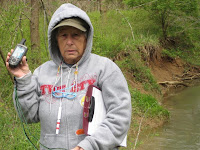
.JPG)

.JPG)
.JPG)
.JPG)
.JPG)

.JPG)

.JPG)
.JPG)


Mom and I left this morning with a bunch of caches in our old GPS as we didn't need the Tom-Tom today because I finally got some maps loaded. Again most of the caches were NRV so we don't have much to write about today. We 3 or 4 in the woods, one in a small cemetery, couple on guardrails, one on a light post skirt and one on a Ryan's Steakhouse sign post.
One cache we did that was interesting was in a small family cemetery in the woods behind a motel. The Hardin County area has several graves of soldiers that lived during this turbulent time. John Swank as his headstone testifies was part of the Virginia Militia. During the American Revolution pioneers from the newly settled west not only fought for their Independence they also fought off Indian attacks against the already established settlements that were part of Virginia that we now know as Kentucky. The Indian attacks in Kentucky and Hardin county was as fierce or fiercer than any battles fought in the east, their grim defense prevented Indian insurrection into the former colonies even as war-weary backcountry riflemen finally witnessed the surrender of the army of Lord Cornwallis at Yorktown, Virginia, on October 17, 1781. This surrender was no deterrent to the Shawnees, Miamis, Mingos, Wyandots, Ottawas and other hostile tribes in the Kentucky region of Virginia. These tribes with arms and incitement from British in Canada fought without letup and John Swank was one of these VA militia men.
Another interesting cache was at the Schmitt Museum of Coca-Cola Memoribilia. We didn't visit the museum but did find the cache and may go back for a visit if we have time. The Schmitt Museum of Coca-Cola Memoribilia is the world's largest privately owned collection of Coca-Cola memoribilia. See rare vending machines and antique bottling equipment used over 100 years ago. In addition to the famous Coca-Cola serving trays and calendars, visitors to the museum will find everyday items such as bottles, beverage glasses, toys, neon and metal signs, sheet music and more all bearing the famous trademark.
This the time we got our phone call from the Sheriff's Department in Paducah that someone had turned our GPS into a deputy on Saturday and wanted to know how we wanted to get it back. Well there was only one way and that was to go get it because they really didn't want to bother sending it to us. So we are planning a trip to Paducah (175 miles one way) tomorrow to pick it up.
We did do one Earthcache that had to do with creek and stream erosion. We had to walk into the woods to a stream and take notice of the different layers of shale and sandstone in the exposed cut banks. A cut bank is an erosional feature of streams. Cut banks are found in abundance along mature or meandering streams, they are located on the outside of a stream bend, known as a meander. They are shaped much like a small cliff, and are formed by the erosion of soil as the stream collides with the river bank. Stream Channel Erosion. Stream channel erosion consists of both stream bed and stream bank erosion. Stream bed erosion occurs as flows cut into the bottom of the channel, making it deeper. This erosion process will continue until the channel reaches a stable slope. The resulting slope is dependant on the channel materials, and flow properties. As the stream bed erodes, and the channel deepens, the sides of the channel become unstable and slough off; resulting in stream bank erosion. Stream bank erosion can also occur as soft materials are eroded from the stream bank or at bends in the channel. This type of stream bank erosion results in meandering waterways. One significant cause of both steam bed and stream bank erosion is due to the increased frequency and duration of runoff events that are a result of urban development.
Typically, cut banks are nearly vertical and often expose the roots of nearby plant life. Often, particularly during periods of high rainfall and higher-than average water levels, trees and poorly placed buildings can fall into the stream due to mass wasting events. Given enough time, the combination of erosion along cut banks and deposition along point bars can lead to the formation of an oxbow lake.
Not only are cut banks steep and unstable, they are also the area of a stream where the water is flowing the fastest and the deepest, making them rather dangerous. Geologically speaking, this is known as an area of high-energy.
We made our observations and answered the needed questions and took our picture and we were off back to the RV as it was getting colder and cloudy. When we got back we had lunch and Mom did our logs and I caught up on the blog and pictures and by that time it was dinner time. We ate and called it a day. Well until next time we are going to close and we love and miss you all.

No comments:
Post a Comment